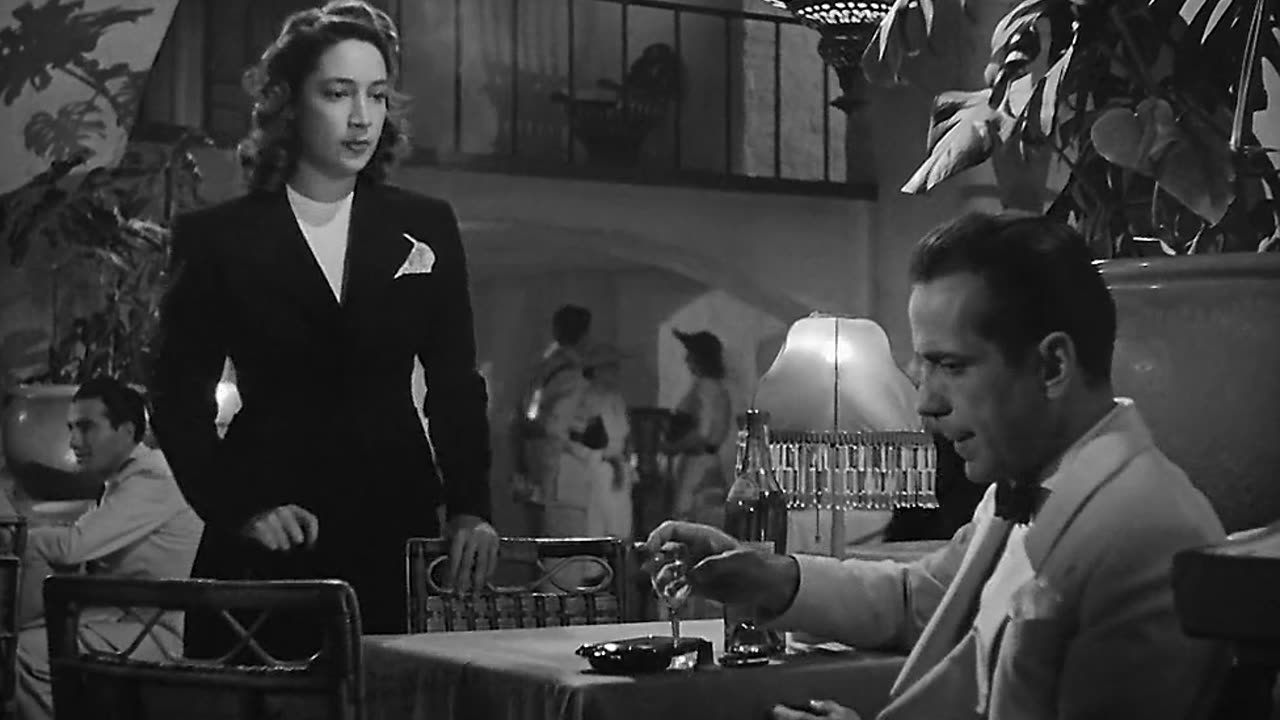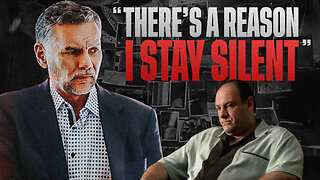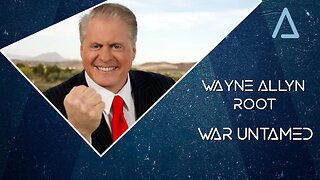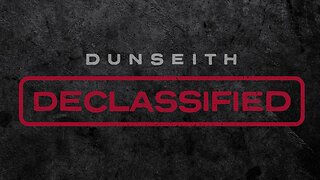Premium Only Content

Casablanca (1942) - Full Film
Casablanca is a 1942 American romantic drama film directed by Michael Curtiz and starring Humphrey Bogart, Ingrid Bergman, and Paul Henreid. Filmed and set during World War II, it focuses on an American expatriate (Bogart) who must choose between his love for a woman (Bergman) and helping her husband (Henreid), a Czechoslovak resistance leader, escape from the Vichy-controlled city of Casablanca to continue his fight against the Germans. The screenplay is based on Everybody Comes to Rick's, an unproduced stage play by Murray Burnett and Joan Alison. The supporting cast features Claude Rains, Conrad Veidt, Sydney Greenstreet, Peter Lorre, and Dooley Wilson.
Warner Bros. story editor Irene Diamond convinced producer Hal B. Wallis to purchase the film rights to the play in January 1942. Brothers Julius and Philip G. Epstein were initially assigned to write the script. However, despite studio resistance, they left to work on Frank Capra's Why We Fight series early in 1942. Howard Koch was assigned to the screenplay until the Epsteins returned a month later. Principal photography began on May 25, 1942, ending on August 3; the film was shot entirely at Warner Bros. Studios in Burbank, California, with the exception of one sequence at Van Nuys Airport in Los Angeles.
Although Casablanca was an A-list film with established stars and first-rate writers, no one involved with its production expected it to stand out among the many pictures produced by Hollywood yearly.[7] Casablanca was rushed into release to take advantage of the publicity from the Allied invasion of North Africa a few weeks earlier.[8] It had its world premiere on November 26, 1942, in New York City and was released nationally in the United States on January 23, 1943. The film was a solid if unspectacular success in its initial run.
Exceeding expectations, Casablanca went on to win the Academy Award for Best Picture, while Curtiz was selected as Best Director and the Epsteins and Koch were honored for Best Adapted Screenplay. Its reputation has gradually grown, to the point that its lead characters,[9] memorable lines,[10] and pervasive theme song[11] have all become iconic, and it consistently ranks near the top of lists of the greatest films in history. In 1989, the United States Library of Congress selected the film as one of the first for preservation in the National Film Registry for being "culturally, historically, or aesthetically significant".
Plot
Black-and-white film screenshot of several people in a nightclub. A man on the far left is wearing a suit and has a woman standing next to him wearing a hat and dress. A man at the center is looking at the man on the left. A man on the far right is wearing a suit and looking at the other people.
Left to right: Henreid, Bergman, Rains and Bogart
Duration: 2 minutes and 15 seconds.2:15
Original trailer
In December 1941, American expatriate Rick Blaine owns a nightclub and gambling den in Casablanca. "Rick's Café Américain" attracts a varied clientele, including Vichy French and Nazi German officials, refugees desperate to reach the neutral United States, and those who prey on them. Although Rick professes to be neutral in all matters, he ran guns to Ethiopia in 1935 and fought on the Loyalist side in the Spanish Civil War.
Petty crook Ugarte boasts to Rick of letters of transit obtained by murdering two German couriers. The papers allow the bearers to travel freely around German-occupied Europe and to neutral Portugal. Ugarte plans to sell them at the club and persuades Rick to hold them. Before he can meet his contact, Ugarte is arrested by the local police under Captain Louis Renault, the unabashedly corrupt prefect of police. Ugarte dies in custody without revealing that Rick has the letters.
Then the reason for Rick's cynical nature—former lover Ilsa Lund—enters his establishment. Spotting Rick's friend and house pianist, Sam, Ilsa asks him to play "As Time Goes By". Rick storms over, furious that Sam disobeyed his order never to perform that song again, and is stunned to see Ilsa. She is accompanied by her husband, Victor Laszlo, a renowned fugitive Czechoslovak Resistance leader. A flashback reveals Ilsa left Rick without explanation when the couple were planning to flee as the German army neared Paris, embittering Rick. Laszlo and Ilsa need the letters to escape, while German Major Strasser arrives in Casablanca to prevent just that.
When Laszlo makes inquiries, Signor Ferrari, an underworld figure and Rick's friendly business rival, divulges his suspicion that Rick has the letters. Laszlo returns to Rick's cafe that night and tries to buy them. Rick refuses to sell, telling Laszlo to ask his wife why. They are interrupted when Strasser leads a group of German officers in singing "Die Wacht am Rhein". Laszlo orders the house band to play "La Marseillaise". When the bandleader looks to Rick, the latter nods, and Laszlo begins to sing. Patriotic fervor grips the crowd, and everyone joins in, drowning out the Germans. Afterwards, Strasser has Renault close the club on a flimsy pretext.
Black-and-white film screenshot of a man and woman as seen from the shoulders up. The two are close to each other as if about to kiss.
Bogart and Bergman
Later, Ilsa confronts Rick in the deserted café; when he refuses to give her the letters, she threatens him with a gun but then confesses that she still loves him. She explains that when they met and fell in love in Paris in 1940, she believed her husband had been killed attempting to escape from a concentration camp. Then she learned that Laszlo was alive and hiding near Paris. She left Rick without explanation to nurse her sick husband. Rick's bitterness dissolves. He agrees to help, letting her believe she will stay with him when Laszlo leaves. When Laszlo unexpectedly shows up, having narrowly escaped a police raid on a Resistance meeting, Rick has waiter Carl spirit Ilsa away. Laszlo, aware of Rick's love for Ilsa, tries to persuade him to use the letters to take her to safety.
When the police arrest Laszlo on a trumped-up charge, Rick persuades Renault to release him by promising to set him up for a much more serious crime: possession of the letters. To allay Renault's suspicions, Rick explains that he and Ilsa will use the letters to leave for America. When Renault tries to arrest Laszlo as arranged, however, Rick forces him at gunpoint to assist in their escape. At the last moment, Rick makes Ilsa board the plane to Lisbon with Laszlo, telling her that she would regret it if she stayed, "Maybe not today, maybe not tomorrow, but soon and for the rest of your life." Strasser, tipped off by Renault, drives up alone. When Strasser attempts to stop the plane, Rick shoots him dead. Policemen arrive. Renault pauses, then orders them to "round up the usual suspects." He suggests to Rick that they join the Free French in Brazzaville. As they walk away into the fog, Rick says, "Louis, I think this is the beginning of a beautiful friendship."
Cast
Black-and-white film screenshot of two men, both wearing suits. The man on the left is older and is nearly bald; the man on the right has black hair. In the background several bottles of alcohol can be seen.
Greenstreet and Bogart
The play's cast consisted of 16 speaking parts and several extras; the film script enlarged it to 22 speaking parts and hundreds of extras.[12] The cast is notably international: only three of the credited actors were born in the United States (Bogart, Dooley Wilson, and Joy Page). The top-billed actors are:[13]
Humphrey Bogart as Rick Blaine
Ingrid Bergman as Ilsa Lund. Bergman's official website calls Ilsa her "most famous and enduring role".[14] The Swedish actress's Hollywood debut in Intermezzo had been well received, but her subsequent films were not major successes until Casablanca. Film critic Roger Ebert called her "luminous", and commented on the chemistry between her and Bogart: "she paints his face with her eyes".[15] Other actresses considered for the role of Ilsa included Ann Sheridan, Hedy Lamarr, Luise Rainer, and Michèle Morgan. Producer Hal Wallis obtained the services of Bergman, who was contracted to David O. Selznick, by lending Olivia de Havilland in exchange.[16]
Paul Henreid as Victor Laszlo. Henreid, an Austrian actor who had emigrated in 1935, was reluctant to take the role (it "set [him] as a stiff forever", according to Pauline Kael[17]), until he was promised top billing along with Bogart and Bergman. Henreid did not get on well with his fellow actors; he considered Bogart "a mediocre actor"; Bergman called Henreid a "prima donna".[18]
The second-billed actors are:
Claude Rains as Captain Louis Renault
Conrad Veidt as Major Heinrich Strasser. Veidt was a refugee German actor who had fled the Nazis with his Jewish wife, but frequently played Nazis in American films. He was the highest paid member of the cast despite his second billing.[19]
Sydney Greenstreet as Signor Ferrari
Peter Lorre as Signor Ugarte
Also credited are:
Curt Bois as the pickpocket. Bois had one of the longest careers in cinema, spanning over 80 years.
Leonid Kinskey as Sascha, the Russian bartender infatuated with Yvonne. Kinskey told Aljean Harmetz, author of Round Up the Usual Suspects: The Making of Casablanca, that he was cast because he was Bogart's drinking buddy. He was not the first choice for the role; he replaced Leo Mostovoy, who was deemed not funny enough.[20]
Madeleine Lebeau as Yvonne, Rick's soon-discarded girlfriend. Lebeau was a French refugee who had left Nazi-occupied Europe with her husband Marcel Dalio, who was a fellow Casablanca performer. She was the last surviving cast member until her death on May 1, 2016.[21]
Joy Page, the step-daughter of studio head Jack L. Warner, as Annina Brandel, the young Bulgarian refugee
John Qualen as Berger, Laszlo's Resistance contact
S. Z. Sakall (credited as S. K. Sakall) as Carl, the waiter
Dooley Wilson as Sam. Wilson was one of the few American-born members of the cast. A drummer, he had to fake playing the piano. Even after shooting had been completed, producer Wallis considered dubbing over Wilson's voice for the songs.[22]
Notable uncredited actors are:
Marcel Dalio as Emil the croupier. Dalio had been a star in French cinema, appearing in Jean Renoir's La Grande Illusion and La Règle du Jeu
Helmut Dantine as Jan Brandel, the Bulgarian roulette player married to Annina Brandel
Gregory Gaye as the German banker who is refused entry to the casino by Rick
Torben Meyer as the Dutch banker who runs "the second largest banking house in Amsterdam"
Corinna Mura as the guitar player who sings "Tango Delle Rose" (or "Tango de la Rosa") and later accompanies the crowd on "La Marseillaise"
Frank Puglia as a Moroccan rug merchant
Richard Ryen as Colonel Heinze, Strasser's aide
Dan Seymour as Abdul the doorman
Gerald Oliver Smith as the Englishman whose wallet is stolen
Norma Varden as the Englishwoman whose husband has his wallet stolen
Much of the emotional impact of the film, for the audience in 1942, has been attributed to the large proportion of European exiles and refugees who were extras or played minor roles (in addition to leading actors Paul Henreid, Conrad Veidt and Peter Lorre), such as Louis V. Arco, Trude Berliner, Ilka Grünig, Ludwig Stössel, Hans Heinrich von Twardowski, and Wolfgang Zilzer. A witness to the filming of the "duel of the anthems" sequence said he saw many of the actors crying and "realized that they were all real refugees".[23] Harmetz argues that they "brought to a dozen small roles in Casablanca an understanding and a desperation that could never have come from Central Casting".[24] Even though many were Jewish or refugees from the Nazis (or both), they were frequently cast as Nazis in various war films, because of their accents.
Jack Benny may have appeared in an unbilled cameo, as was claimed by a contemporary newspaper advertisement and in the Casablanca press book.[25][26][27] When asked in his column "Movie Answer Man", critic Roger Ebert first replied, "It looks something like him. That's all I can say."[26] In a later column, he responded to a follow-up commenter, "I think you're right. The Jack Benny Fan Club can feel vindicated".[28]
Writing
The film was based on Murray Burnett and Joan Alison's unproduced play Everybody Comes to Rick's.[29] The Warner Bros. story analyst who read the play, Stephen Karnot, called it (approvingly) "sophisticated hokum"[30] and story editor Irene Diamond, who had discovered the script on a trip to New York in 1941, convinced Hal Wallis to buy the rights in January 1942 for $20,000 (equivalent to $290,000 in 2021),[31] the most anyone in Hollywood had ever paid for an unproduced play.[32] The project was renamed Casablanca, apparently in imitation of the 1938 hit Algiers.[33] Casablanca also shares many narrative and thematic similarities with Algiers (1938), which itself is a remake of the acclaimed 1937 French film Pépé le Moko, directed and co-written by Julien Duvivier.[34]
The original play was inspired by a trip to Europe made by Murray Burnett and his wife in 1938, during which they visited Vienna shortly after the Anschluss and were affected by the antisemitism they saw. In the south of France, they went to a nightclub that had a multinational clientele, among them many exiles and refugees, and the prototype of Sam.[35] In The Guardian, Paul Fairclough wrote that Cinema Vox in Tangier "was Africa's biggest when it opened in 1935, with 2,000 seats and a retractable roof. As Tangier was in Spanish territory [sic], the theatre's wartime bar heaved with spies, refugees and underworld hoods, securing its place in cinematic history as the inspiration for Rick's Cafe in Casablanca."[36][37] The scene of the singing of "La Marseillaise" in the bar is attributed by the film scholar Julian Jackson as an adaptation of a similar scene from Jean Renoir's film La Grande Illusion five years prior.[38]
The first writers assigned to the script were twins Julius and Philip Epstein[39] who, against the wishes of Warner Bros., left at Frank Capra's request early in 1942 to work on the Why We Fight series in Washington, D.C.[40][41] While they were gone, the other credited writer, Howard Koch, was assigned; he produced thirty to forty pages.[41] When the Epstein brothers returned after about a month, they were reassigned to Casablanca and—contrary to what Koch claimed in two published books—his work was not used.[41] The Epstein brothers and Koch never worked in the same room at the same time during the writing of the script. In the final budget for the film, the Epsteins were paid $30,416, (equivalent to $398,552 in 2021) and Koch earned $4,200 (equivalent to $55,797 in 2021).[42]
In the play, the Ilsa character is an American named Lois Meredith; she does not meet Laszlo until after her relationship with Rick in Paris has ended. Rick is a lawyer. The play (set entirely in the cafe) ends with Rick sending Lois and Laszlo to the airport. To make Rick's motivation more believable, Wallis, Curtiz, and the screenwriters decided to set the film before the attack on Pearl Harbor.[43]
The possibility was discussed of Laszlo being killed in Casablanca, allowing Rick and Ilsa to leave together, but as Casey Robinson wrote to Wallis before filming began, the ending of the film
"set up for a swell twist when Rick sends her away on the plane with Laszlo. For now, in doing so, he is not just solving a love triangle. He is forcing the girl to live up to the idealism of her nature, forcing her to carry on with the work that in these days is far more important than the love of two little people."[44]
It was certainly impossible for Ilsa to leave Laszlo for Rick, as the Motion Picture Production Code forbade showing a woman leaving her husband for another man. The concern was not whether Ilsa would leave with Laszlo, but how this outcome would be engineered.[45] According to Julius Epstein, he and Philip were driving when they simultaneously came up with the idea for Renault to order the roundup of "the usual suspects", after which all the details needed for resolution of the story, including the farewell between Bergman and "a suddenly noble Bogart", were rapidly worked out.[46]
The uncredited Casey Robinson assisted with three weeks of rewrites, including contributing the series of meetings between Rick and Ilsa in the cafe.[47][48] Koch highlighted the political and melodramatic elements,[49][50] and Curtiz seems to have favored the romantic parts, insisting on retaining the Paris flashbacks.[51]
In a telegram to film editor Owen Marks on August 7, 1942, Wallis suggested two possible final lines of dialogue for Rick: "Louis, I might have known you'd mix your patriotism with a little larceny" or "Louis, I think this is the beginning of a beautiful friendship".[52] Two weeks later, Wallis settled on the latter, which Bogart was recalled to dub a month after shooting had finished.[51]
Bogart's line "Here's looking at you, kid", said four times, was not in the draft screenplays, but has been attributed to a comment he made to Bergman as she played poker with her English coach and hairdresser between takes.[53]
Despite the many writers, the film has what Ebert describes as a "wonderfully unified and consistent" script. Koch later claimed it was the tension between his own approach and Curtiz's that had accounted for this. "Surprisingly, these disparate approaches somehow meshed, and perhaps it was partly this tug of war between Curtiz and me that gave the film a certain balance."[54] Julius Epstein later noted the screenplay contained "more corn than in the states of Kansas and Iowa combined. But when corn works, there's nothing better".[55]
The film ran into some trouble with Joseph Breen of the Production Code Administration (the Hollywood self-censorship body), who opposed the suggestions that Captain Renault extorted sexual favors from visa applicants, and that Rick and Ilsa had slept together.[56][57] Extensive changes were made, with several lines of dialogue removed or altered. All direct references to sex were deleted; Renault's selling of visas for sex, and Rick and Ilsa's previous sexual relationship were implied elliptically rather than referenced explicitly.[58] Also, in the original script, when Sam plays "As Time Goes By", Rick exclaims, "What the —— are you playing?" This line was altered to "Sam, I thought I told you never to play ..." to conform to Breen's objection to an implied swear word.[59]
Production
Bogart in the airport scene
Although an initial filming date was selected for April 10, 1942, delays led to production starting on May 25.[60] Filming was completed on August 3. It went $75,000 over budget for a total cost of $1,039,000 (equivalent to $13,803,000 in 2021),[61] above average for the time.[62] Unusually, the film was shot in sequence, mainly because only the first half of the script was ready when filming began.[63]
The entire picture was shot in the studio except for the sequence showing Strasser's arrival and close-ups of the Lockheed Electra (filmed at Van Nuys Airport) and a few short clips of stock footage views of Paris.[64] The street used for the exterior shots had recently been built for another film, The Desert Song,[65] and redressed for the Paris flashbacks.
The film critic Roger Ebert called Wallis the "key creative force" for his attention to the details of production (down to insisting on a real parrot in the Blue Parrot bar).[15]
The difference between Bergman's and Bogart's height caused some problems. She was two inches (5 cm) taller than Bogart, and claimed Curtiz had Bogart stand on blocks or sit on cushions in their scenes together.[66]
Later, there were plans for a further scene, showing Rick, Renault and a detachment of Free French soldiers on a ship, to incorporate the Allies' 1942 invasion of North Africa. It proved too difficult to get Claude Rains for the shoot, and the scene was finally abandoned after David O. Selznick judged "it would be a terrible mistake to change the ending".[67][19]
The background of the final scene, which shows a Lockheed Model 12 Electra Junior airplane with personnel walking around it, was staged using little person extras and a proportionate cardboard plane.[68] Fog was used to mask the model's unconvincing appearance.[69]
Direction
Wallis's first choice for director was William Wyler, but he was unavailable, so Wallis turned to his close friend Michael Curtiz.[70][19] Roger Ebert has commented that in Casablanca "very few shots ...are memorable as shots", as Curtiz wanted images to express the story rather than to stand alone.[15] He contributed relatively little to development of the plot. Casey Robinson said Curtiz "knew nothing whatever about story ...he saw it in pictures, and you supplied the stories".[71]
Critic Andrew Sarris called the film "the most decisive exception to the auteur theory",[72] of which Sarris was the most prominent proponent in the United States. Aljean Harmetz has responded, "...nearly every Warner Bros. picture was an exception to the auteur theory".[70] Other critics give more credit to Curtiz. Sidney Rosenzweig, in his study of the director's work, sees the film as a typical example of Curtiz's highlighting of moral dilemmas.[73]
Some of the second unit montages, such as the opening sequence of the refugee trail and the invasion of France, were directed by Don Siegel.[74]
Cinematography
The cinematographer was Arthur Edeson, a veteran who had previously shot The Maltese Falcon and Frankenstein. Particular attention was paid to photographing Bergman. She was shot mainly from her preferred left side, often with a softening gauze filter and with catch lights to make her eyes sparkle; the whole effect was designed to make her face seem "ineffably sad and tender and nostalgic".[15] Bars of shadow across the characters and in the background variously imply imprisonment, the crucifix, the symbol of the Free French Forces and emotional turmoil.[15] Dark film noir and expressionist lighting was used in several scenes, particularly towards the end of the picture. Rosenzweig argues these shadow and lighting effects are classic elements of the Curtiz style, along with the fluid camera work and the use of the environment as a framing device.[75]
Soundtrack
The music was written by Max Steiner, who wrote scores for King Kong and Gone with the Wind. The song "As Time Goes By" by Herman Hupfeld had been part of the story from the original play; Steiner wanted to write his own composition to replace it, but Bergman had already cut her hair short for her next role (María in For Whom the Bell Tolls) and could not reshoot the scenes that incorporated the song,[a] so Steiner based the entire score on it and "La Marseillaise", the French national anthem, transforming them as leitmotifs to reflect changing moods.[76] Even though Steiner disliked "As Time Goes By", he admitted in a 1943 interview that it "must have had something to attract so much attention".[77] Dooley Wilson, who played Sam, was a drummer but not a pianist, so his piano playing was performed by Jean Plummer.[78]
Particularly memorable is the "duel of the anthems" between Strasser and Laszlo at Rick's cafe.[19] In the soundtrack, "La Marseillaise" is played by a full orchestra. Originally, the opposing piece for this iconic sequence was to be the "Horst Wessel Lied", a Nazi anthem but this was still under international copyright in non-Allied countries. Instead "Die Wacht am Rhein" was used.[79] The "Deutschlandlied", the national anthem of Germany, is used several times in minor mode as a leitmotif for the German threat, e.g. in the scene in Paris as it is announced that the German army will reach Paris the next day. It is featured in the final scene, giving way to "La Marseillaise" after Strasser is shot.[80][19]
Other songs include:
"It Had to Be You", music by Isham Jones, lyrics by Gus Kahn
"Shine", music by Ford Dabney, lyrics by Cecil Mack and Lew Brown
"Avalon", music and lyrics by Al Jolson, Buddy DeSylva and Vincent Rose
"Perfidia", by Alberto Dominguez
"The Very Thought of You", by Ray Noble
"Knock on Wood", music by M. K. Jerome, lyrics by Jack Scholl, the only original song.
Very few films in the early 1940s had portions of the soundtrack released on 78 rpm records, and Casablanca was no exception. In 1997, almost 55 years after the film's premiere, Turner Entertainment in collaboration with Rhino Records issued the film's first original soundtrack album for release on compact disc, including original songs and music, spoken dialogue, and alternate takes.[81]
The piano featured in the Paris flashback sequences was sold in New York City on December 14, 2012, at Sotheby's for more than $600,000 to an anonymous bidder.[82] The piano Sam "plays" in Rick's Café Américain, put up for auction with other film memorabilia by Turner Classic Movies at Bonhams in New York on November 24, 2014, sold for $3.4 million.[83][84]
Release
Although an initial release date was anticipated for early 1943,[85] the film premiered at the Hollywood Theater in New York City on November 26, 1942, to capitalize on Operation Torch (the Allied invasion of French North Africa) and the capture of Casablanca.[8][86] It went into general release on January 23, 1943, to take advantage of the Casablanca Conference, a high-level meeting in the city between British Prime Minister Winston Churchill and American President Franklin D. Roosevelt. The Office of War Information prevented screening of the film to troops in North Africa, believing it would cause resentment among Vichy supporters in the region.[87]
Irish and German cuts
On March 19, 1943, the film was banned in Ireland for infringing on the Emergency Powers Order preserving wartime neutrality, by portraying Vichy France and Nazi Germany in a "sinister light". It was passed with cuts on June 15, 1945, shortly after the EPO was lifted. The cuts were made to dialogue between Rick and Ilsa referring to their love affair.[88] A version with only one scene cut was passed on July 16, 1974; Irish national broadcaster RTÉ inquired about showing the film on TV, but found it still required a dialogue cut to Ilsa expressing her love for Rick.[89]
Warner Brothers released a heavily edited version of Casablanca in West Germany in 1952. All scenes with Nazis were removed, along with most references to World War II. Important plot points were altered when the dialogue was dubbed into German. Victor Laszlo was no longer a Resistance fighter who escaped from a Nazi concentration camp. Instead, he became a Norwegian atomic physicist who was being pursued by Interpol after he "broke out of jail". The West German version was 25 minutes shorter than the original cut. A German version of Casablanca with the original plot was not released until 1975.[90]
Reception
Initial response
Casablanca received "consistently good reviews".[91] Bosley Crowther of The New York Times wrote, "The Warners ... have a picture which makes the spine tingle and the heart take a leap." He applauded the combination of "sentiment, humor and pathos with taut melodrama and bristling intrigue." Crowther noted its "devious convolutions of the plot" and praised the screenplay quality as "of the best" and the cast's performances as "all of the first order".[92]
The trade paper Variety commended the film's "combination of fine performances, engrossing story and neat direction" and the "variety of moods, action, suspense, comedy and drama that makes Casablanca an A-1 entry at the b.o."[93] The review observed that the "[f]ilm is splendid anti-Axis propaganda, particularly inasmuch as the propaganda is strictly a by-product of the principal action and contributes to it instead of getting in the way".[93] Variety also applauded the performances of Bergman and Henreid and noted, "Bogart, as might be expected, is more at ease as the bitter and cynical operator of a joint than as a lover, but handles both assignments with superb finesse."[93]
Some reviews were less enthusiastic. The New Yorker rated Casablanca only "pretty tolerable" and said it was "not quite up to Across the Pacific, Bogart's last spyfest".[94]
At the 1,500-seat Hollywood Theater, the film grossed $255,000 over ten weeks (equivalent to $3.4 million in 2021).[95] In its initial American release, Casablanca was a substantial but not spectacular box-office success, earning $3.7 million (equivalent to $49 million in 2021).[95][96] A 50th-anniversary re-release grossed $1.5 million in 1992.[97] According to Warner Bros. records, the film earned $3,398,000 domestically and $3,461,000 in foreign markets.[4]
Enduring popularity
In the decades since its release, the film has grown in reputation. Murray Burnett called it "true yesterday, true today, true tomorrow".[98] By 1955, the film had brought in $6.8 million, making it the third-most-successful of Warners' wartime movies, behind Shine On, Harvest Moon and This Is the Army.[99] On April 21, 1957, the Brattle Theater of Cambridge, Massachusetts, showed the film as part of a season of old movies. It proved so popular that a tradition began in which Casablanca would be screened during the week of final exams at Harvard University. Todd Gitlin, a professor of sociology who had attended one of these screenings, has said that the experience was "the acting out of my own personal rite of passage".[100] The tradition helped the film remain popular while other films that had been famous in the 1940s have faded from popular memory. By 1977, Casablanca had become the most frequently broadcast film on American television.[101]
Ingrid Bergman's portrayal of Ilsa Lund in Casablanca became one of her best-known roles.[102] In later years she said, "I feel about Casablanca that it has a life of its own. There is something mystical about it. It seems to have filled a need, a need that was there before the film, a need that the film filled."[103]
On the film's 50th anniversary, the Los Angeles Times called Casablanca's great strength "the purity of its Golden Age Hollywoodness [and] the enduring craftsmanship of its resonantly hokey dialogue". Bob Strauss wrote in the newspaper that the film achieved a "near-perfect entertainment balance" of comedy, romance, and suspense.[104]
Roger Ebert, wrote of Casablanca in 1992, "There are greater movies. More profound movies. Movies of greater artistic vision or artistic originality or political significance. ... But [it is] one of the movies we treasure the most ... This is a movie that has transcended the ordinary categories."[105] In his opinion, the film is popular because "the people in it are all so good" and it is "a wonderful gem".[15] Ebert said that he had never heard of a negative review of the film, even though individual elements can be criticized, citing unrealistic special effects and the stiff character of Laszlo as portrayed by Paul Henreid.[71]
The critic Leonard Maltin considers Casablanca "the best Hollywood movie of all time".[106]
According to Rudy Behlmer, the character of Rick is "not a hero ... not a bad guy" because he does what is necessary to appease the authorities and "sticks his neck out for nobody". Behlmer feels that the other characters are "not cut and dried" and come into their goodness over the course of the film. Renault begins as a collaborator with the Nazis who extorts sexual favors from refugees and has Ugarte killed. Even Ilsa, the least active of the main characters, is "caught in the emotional struggle" over which man she really loves. By the end, however, "everybody is sacrificing".[71] Behlmer also emphasized the variety in the picture. "It's a blend of drama, melodrama, comedy [and] intrigue."[71]
A remembrance written for the film's 75th anniversary published by The Washington Free Beacon said, "It is no exaggeration to say Casablanca is one of the greatest films ever made," making special note of the "intellectual nature of the film" and saying that "while the first time around you might pay attention to only the superficial love story, by the second and third and fourth viewings the sub-textual politics [of communitarianism and anti-isolationism] have moved to the fore".[107]
A few reviewers have expressed reservations. To Pauline Kael, "It's far from a great film, but it has a special appealingly schlocky romanticism ..."[108] Umberto Eco wrote that "by any strict critical standards ... Casablanca is a very mediocre film". He viewed the changes that the characters manifest as inconsistent rather than complex. "It is a comic strip, a hotchpotch, low on psychological credibility, and with little continuity in its dramatic effects." However, he added that because of the presence of multiple archetypes that allow "the power of Narrative in its natural state without Art intervening to discipline it", it is a film reaching "Homeric depths" as a "phenomenon worthy of awe".[109]
On the review aggregator website Rotten Tomatoes, 99% of 127 critics' reviews are positive, with an average rating of 9.4/10. The website's consensus reads, "An undisputed masterpiece and perhaps Hollywood's quintessential statement on love and romance, Casablanca has only improved with age, boasting career-defining performances from Humphrey Bogart and Ingrid Bergman."[110] On Metacritic, the film has a perfect score of 100 out of 100, based on 18 critics, indicating "universal acclaim".[111] It is one of the few films in the site's history to achieve a perfect aggregate score.[112]
In the November/December 1982 issue of Film Comment, Chuck Ross wrote that he retyped the Casablanca screenplay, reverting the title to Everybody Comes to Rick's and changing the name of Sam the piano player to Dooley (after Dooley Wilson, who played the character), and submitted it to 217 agencies. The majority of agencies returned the script unread (often because of policies regarding unsolicited screenplays) or did not respond. However, of those which did respond, only 33 specifically recognized it as Casablanca. Eight others observed that it was similar to Casablanca, and 41 agencies rejected the screenplay outright, offering comments such as "Too much dialogue, not enough exposition, the story line was weak, and in general didn't hold my interest." Three agencies offered to represent the screenplay, and one suggested turning it into a novel.[113][114][115]
Influence on later works
Many subsequent films have drawn on elements of Casablanca. Passage to Marseille (1944) reunited actors Bogart, Rains, Greenstreet, and Lorre and director Curtiz in 1944,[116] and there are similarities between Casablanca and a later Bogart film, To Have and Have Not (also 1944).[117] Parodies have included the Marx Brothers' A Night in Casablanca (1946), Neil Simon's The Cheap Detective (1978), and Out Cold (2001). Indirectly, it provided the title for the 1995 neo-noir film The Usual Suspects.[118] Woody Allen's Play It Again, Sam (1972) appropriated Bogart's Casablanca character as the fantasy mentor for Allen's character.[119]
The film was a plot device in the science-fiction television movie Overdrawn at the Memory Bank (1983), based on John Varley's story. It was referred to in Terry Gilliam's dystopian Brazil (1985). Warner Bros. produced its own parody in the homage Carrotblanca, a 1995 Bugs Bunny cartoon.[120] The film critic Roger Ebert pointed out the plot of the film Barb Wire (1996) was identical to that of Casablanca.[121] In Casablanca, a novella by Argentine writer Edgar Brau, the protagonist somehow wanders into Rick's Café Américain and listens to a strange tale related by Sam.[122] The 2016 musical film La La Land contains allusions to Casablanca in the imagery, dialogue, and plot.[123] Robert Zemeckis, director of Allied (2016), which is also set in 1942 Casablanca, studied the film to capture the city's elegance.[124] The 2017 Moroccan drama film Razzia, directed by Nabil Ayouch, is mostly set in the city of Casablanca, and its characters frequently discuss the 1942 film.[125]
-
 LIVE
LIVE
BonginoReport
1 hour agoAnti-Trump Lawyer FIGHTS for Illegals to Vote in WY - Nightly Scroll w/ Hayley Caronia (Ep.56)
3,528 watching -
 LIVE
LIVE
Michael Franzese
45 minutes agoWhy You’ll Never Hear Michael Franzese Talk About Mob Murders
727 watching -
 1:37:28
1:37:28
vivafrei
5 hours agoBitcoin Conference in Vegas! Peter Hotez is a Hack Quack! Liverpool Attack Updates & MORE!
38.5K14 -
 LIVE
LIVE
Ark of Grace Ministries
4 hours agoProphetic Warning: AI and the Battle Over America
1,893 watching -
 LIVE
LIVE
Dr. Drew
4 hours agoWhose Biolab Made COVID-19: China's Wuhan or USA's UNC Chapel Hill? Dr. Li-Meng Yan Debates Dr. Clayton Baker – Ask Dr. Drew
993 watching -
 LIVE
LIVE
Grant Stinchfield
39 minutes agoBlind Liberal Zombies and The Reparation's Racket
144 watching -
 51:10
51:10
Kitco NEWS
1 day agoDollar Destruction: Will It End in Depression, Collapse or Civil War? | Tom DiLorenzo
3582 -
 LIVE
LIVE
Wayne Allyn Root | The Root Reaction
4 hours agoThe Root Reaction LIVE | 27 May 2025
56 watching -
 32:04
32:04
Fit'n Fire
2 days ago $0.06 earned338 ARC & the CMMG Dissent -- Is It Better Than 8.6 Blackout?
2177 -
 14:56
14:56
BEK TV
18 hours agoEP #12 – DUNSEITH DECLASSIFIED: TURTLE MOUNTAIN CORPORATION 1970’S ORIGINS
1.12K